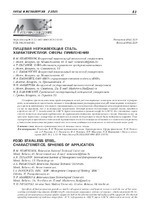| dc.contributor.author | Немененок, Б. М. | |
| dc.contributor.author | Цыганов, А. Р. | |
| dc.contributor.author | Панасюгин, А. С. | |
| dc.contributor.author | Панковец, И. А. | |
| dc.contributor.author | Машерова, Н. П. | |
| dc.contributor.author | Павловский, Н. Д. | |
| dc.coverage.spatial | Минск | ru |
| dc.date.accessioned | 2025-07-01T08:25:02Z | |
| dc.date.available | 2025-07-01T08:25:02Z | |
| dc.date.issued | 2025 | |
| dc.identifier.citation | Пищевая нержавеющая сталь. Характеристики. Сферы применения = Food stainless steel. Characteristics. Spheres of application / Б. М. Немененок, А. Р. Цыганов, А. С. Панасюгин [и др.] // Литье и металлургия. – 2025. – № 2. – С. 83-91. | ru |
| dc.identifier.uri | https://rep.bntu.by/handle/data/157452 | |
| dc.description.abstract | Специфика приготовления пищи предусматривает целый ряд многократных санитарно‑гигиенических мероприятий с использованием горячей воды, моющих и дезинфицирующих растворов различных рН, концентрации, температуры и времени воздействия, что может спровоцировать на некачественном оборудовании начало коррозионного процесса как на наружной, так и на внутренней поверхности. Тепловой режим эксплуатации кухонной посуды находится в пределах от –15 °C (холодильник) до +100 °C (при использовании в духовом шкафу до +250 °C). Все упомянутые марки сталей полностью отвечают требованиям по коррозионной стойкости, предъявляемым к посуде. Емкости из них ни при каких нормальных, оговоренных изготовителем условиях эксплуатации не могут быть подвержены коррозии. Главным критерием пригодности той или иной нержавеющей стали для пищевых целей является ее химическая инертность и допустимое количество миграции химических элементов, входящих в состав стали, из изделий в модельную среду. | ru |
| dc.language.iso | ru | ru |
| dc.publisher | БНТУ | ru |
| dc.title | Пищевая нержавеющая сталь. Характеристики. Сферы применения | ru |
| dc.title.alternative | Food stainless steel. Characteristics. Spheres of application | ru |
| dc.type | Article | ru |
| dc.identifier.doi | 10.21122/1683-6065-2025-2-83-91 | |
| local.description.annotation | Specificity of food preparation provides a number of repeated sanitary and hygienic measures with the use of hot water, washing and disinfecting solutions of different pH, concentration, temperature and time of exposure, which can provoke the beginning of corrosion process on poor‑quality equipment, both on the external and internal surfaces of the equipment. The thermal operating temperature of cookware ranges from –15 °C (refrigerator) to +100 °C (up to +250 °C when used in an oven). All the above‑mentioned steel grades fully meet the corrosion resistance requirements for cookware. Tanks made of these steels cannot be subject to corrosion under any normal operating conditions specified by the manufacturer. The main criterion for the suitability of a particular stainless steel for food applications is its chemical inertness and the permissible amounts of migration of the chemical elements that make up the steel from the products into the modelling medium. | ru |

